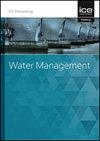危机期间供水的风险评估框架
IF 1.1
4区 工程技术
Q3 ENGINEERING, CIVIL
Proceedings of the Institution of Civil Engineers-Water Management
Pub Date : 2022-03-25
DOI:10.1680/jwama.21.00072
引用次数: 0
摘要
城市供水系统是城市的主要生命线之一,容易受到自然灾害和人为威胁的影响。它也是主要的生命线,为灾后时期提供清洁和健康的水,并为临时避难所、受害者和剩余的居民提供水。在危机期间,缺乏应急供水计划会增加造成的伤亡。本研究旨在通过引入综合风险评估,制定灾害期间的应急供水计划。为此选择的软件包括Arc-GIS和Scenario Wizard,用于准备紧急情况和减少克尔曼沙赫市遭受的自然灾害造成的人员伤亡,作为案例研究。为实现这一计划,应分三个阶段进行。在第一阶段,应使用基于描述符及其交互变量的交叉影响平衡分析(CIB)来确定脆弱性和破坏场景。在第二阶段,应利用地理数据叠加不同层次,绘制饮用水供应方法的风险分区图。在第三阶段,引入了三个支持和供应中心等级,并制定了它们的分布图,这在克尔曼沙阿市实施。地震被认为是主要的破坏事件。本文章由计算机程序翻译,如有差异,请以英文原文为准。
Risk assessment framework for the supply of water during a crisis
A city's water supply system is one of the main lifelines vulnerable to natural hazards and artificial threats. It is also the main lifeline to provide clean and healthy water for the aftermath period and temporary shelters, victims, and remaining residents. During a crisis, the lack of an emergency water supply plan increases the casualties caused. This research aims to develop a supply plan for emergency water during a disaster by introducing a comprehensive risk assessment. The selected software to do this included Arc-GIS and Scenario Wizard to prepare emergencies and reduce the casualties of the natural disasters inflicted on Kermanshah City as a case study. To achieve this plan, three phases should be carried out. In the first phase, the vulnerability and destruction scenarios should be determined using Cross-Impact Balance analysis (CIB) based on the descriptors and their interactive variables. In the second phase, the risk zonation maps with the drinking water supply approach should be developed by using geographical data superposing different layers. In the third phase, three support and supply centre grades are introduced, and their distribution maps are developed, which is implemented for Kermanshah City. Earthquake is considered as the main disruption event.
求助全文
通过发布文献求助,成功后即可免费获取论文全文。
去求助
来源期刊
CiteScore
2.10
自引率
0.00%
发文量
28
审稿时长
6-12 weeks
期刊介绍:
Water Management publishes papers on all aspects of water treatment, water supply, river, wetland and catchment management, inland waterways and urban regeneration.
Topics covered: applied fluid dynamics and water (including supply, treatment and sewerage) and river engineering; together with the increasingly important fields of wetland and catchment management, groundwater and contaminated land, waterfront development and urban regeneration. The scope also covers hydroinformatics tools, risk and uncertainty methods, as well as environmental, social and economic issues relating to sustainable development.

 求助内容:
求助内容: 应助结果提醒方式:
应助结果提醒方式:


